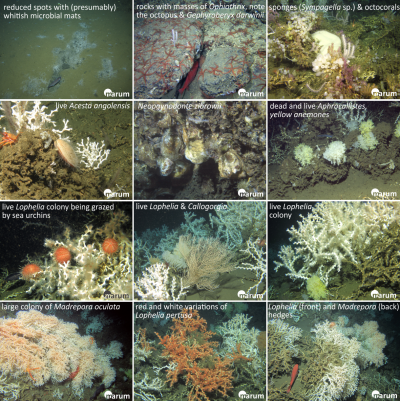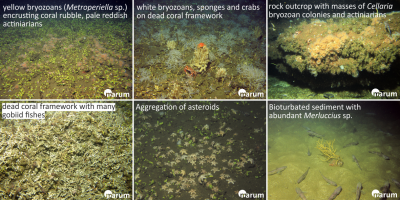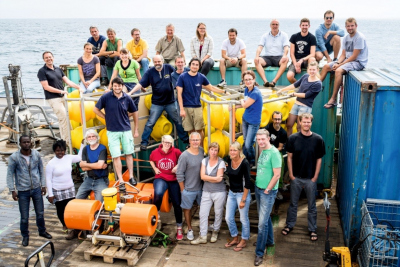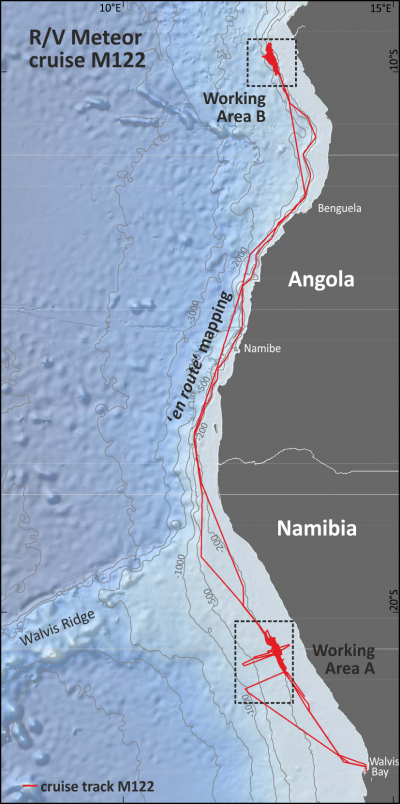Page path:
RV Meteor M122

Cold-water Corals off ANgola and NAmibia
◊ 30. December 2015 - 31. January 2016
◊ Walvis Bay - Walvis Bay
◊ SE Atlantic
◊ MARUM ROV Squid, lander, seimics

Cold-water corals (CWC) are the architects of important bioconstructions in the deep sea and are the nuclei of unique biodiversity hotspots along most of the world's continental margins. Present knowledge about the distribution and ecology of cold-water corals and their sensitivity to environmental change derived mainly from studies on coral sites in the North Atlantic Ocean. For other regions in the Atlantic in particular in the low latitudes, such as the upwelling areas off Namibia and Angola, only few scattered reports of cold-water corals existed to date.
Thus, R/V METEOR expedition M122 focused on the investigation of those CWC occurrences in the Southeast Atlantic Ocean. Special emphasis was on the distribution, the appearance, the faunal assemblage and the vitality of these ecosystems under present and past (glacial) conditions. Based on detailed mapping (MBES, PARASOUND and multichannel seismic) in the two working areas off Namibia and Angola, a total of 16 dives with the MARUM ROV SQUID were conducted to allow for a detailed characterisation of the existing facies and fauna. These observations were complemented by studies on the structure (CTD and water samples) and variability (lander systems) of the water column and by extensive seabed sampling including long sediment cores that will enable to study the development of CWC ecosystems in the Southeast Atlantic under changing environmental conditions, e.g., over glacial-interglacial cycles.
The most remarkable result of the expedition was the observation of living CWC within the oxygen minimum zone off Angola. Thriving CWC under dissolved oxygen concentrations of <1 ml/L, as found off Angola, have never been observed before, neither in nature nor in laboratory experiments. In contrast, off Namibia, where dissolved oxygen concentrations are even lower with <0.5 ml/L, only fossil CWC were encountered. However, their presence is a clear indicator for the existence of better living conditions for the CWC in the past. With the framework-building CWC acting as ecosystem engineers, their vitality is decisive for the local biodiversity in the investigated upper continental slope settings.
Thus, R/V METEOR expedition M122 focused on the investigation of those CWC occurrences in the Southeast Atlantic Ocean. Special emphasis was on the distribution, the appearance, the faunal assemblage and the vitality of these ecosystems under present and past (glacial) conditions. Based on detailed mapping (MBES, PARASOUND and multichannel seismic) in the two working areas off Namibia and Angola, a total of 16 dives with the MARUM ROV SQUID were conducted to allow for a detailed characterisation of the existing facies and fauna. These observations were complemented by studies on the structure (CTD and water samples) and variability (lander systems) of the water column and by extensive seabed sampling including long sediment cores that will enable to study the development of CWC ecosystems in the Southeast Atlantic under changing environmental conditions, e.g., over glacial-interglacial cycles.
The most remarkable result of the expedition was the observation of living CWC within the oxygen minimum zone off Angola. Thriving CWC under dissolved oxygen concentrations of <1 ml/L, as found off Angola, have never been observed before, neither in nature nor in laboratory experiments. In contrast, off Namibia, where dissolved oxygen concentrations are even lower with <0.5 ml/L, only fossil CWC were encountered. However, their presence is a clear indicator for the existence of better living conditions for the CWC in the past. With the framework-building CWC acting as ecosystem engineers, their vitality is decisive for the local biodiversity in the investigated upper continental slope settings.

Living cold-water corals off Angola

Fossil cold-water corals off Namibia

All ROV images are copyright of MARUM, University of Bremen, and are not free available for download. If you are interested to show these images in an exhibition or like to use them for any kind of media, please contact our MARUM public relation office (nstrackbein@marum.de, [Bitte aktivieren Sie Javascript]) or contact directly the chief scientists!
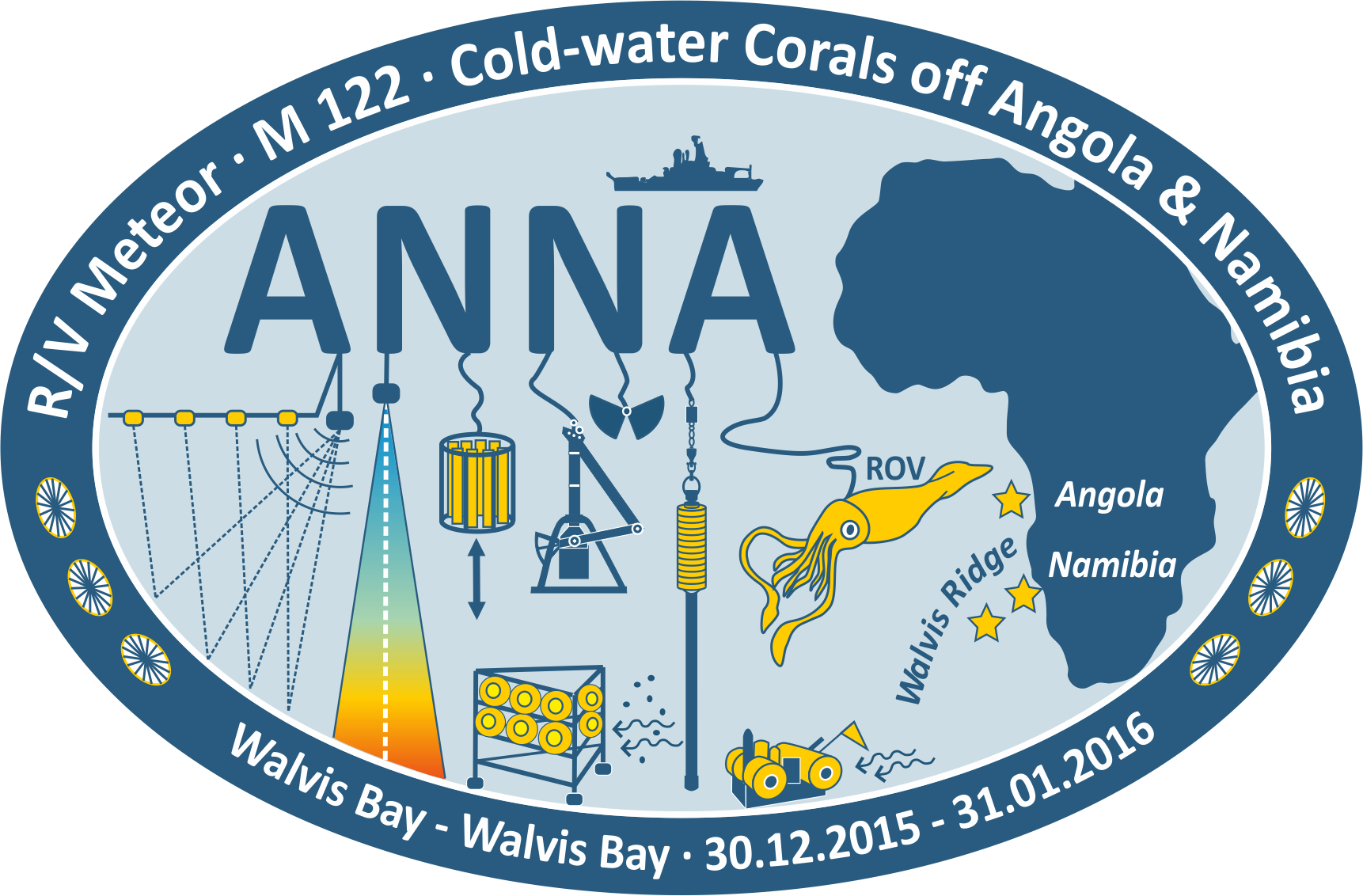

organised by:

Info



Groups involved:
- MTU-GeoB, Uni Bremen
- Senckenberg, WHV
- GEOMAR, Kiel
- IUPH, Uni Heidelberg
- NIOZ, Texel, The Netherlands
- COB-IEO, Baleares, Spain
- UB, Barcelona, Spain
- INIP, Luanda, Angola

Equipment:
- MARUM ROV Squid
- Multichannel seismics
- MBES, PARASOUND, ADCP
- NIOZ Albex lander
- GEOMAR SML-Minilander
- CTD/water sampler
- Gravity corer
- Giant box corer
- Grab sampler




